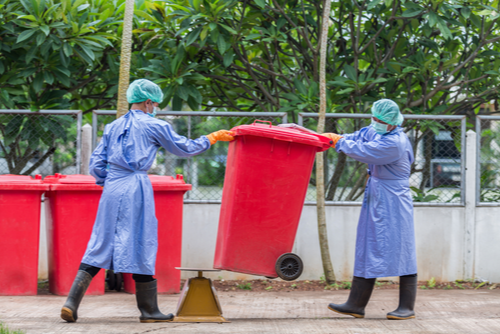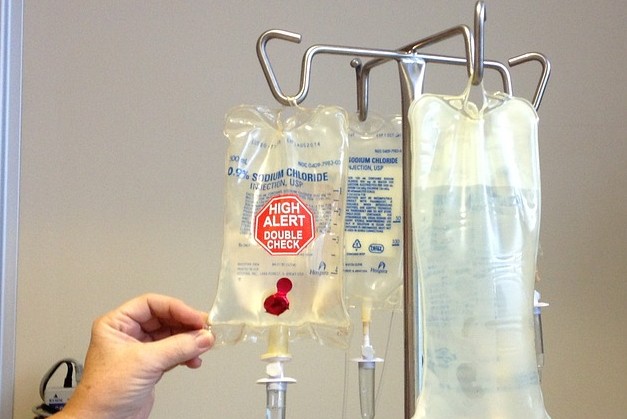Beyond Clean-up: Ensuring Security with Professional Medical Waste Removal
Beyond Clean-up: Ensuring Security with Professional Medical Waste Removal
Blog Article
Remain Ahead of Regulations: Professional Suggestions on Medical Waste Disposal
In a world where the health care market is frequently evolving, it is critical for clinical centers to remain ahead of regulations when it concerns the appropriate disposal of medical waste. With rigid standards and regular governing adjustments, it can be testing to browse the intricacies of this procedure. Nonetheless, with experienced suggestions, centers can make certain conformity and minimize threats connected with inappropriate garbage disposal. From recognizing the various groups of clinical waste to carrying out the appropriate collection and partition approaches, this conversation will certainly give important insights and workable pointers to help centers remain ahead of regulations in the ever-changing landscape of clinical waste disposal.
Comprehending Clinical Waste Categories
Understanding clinical waste categories is essential for appropriate disposal and management in health care facilities. Clinical waste refers to any type of waste created by health care tasks that may present a threat to public health and wellness or the setting. It is important to classify medical waste precisely to guarantee its safe handling, disposal, transport, and therapy.
There are a number of groups of clinical waste that healthcare facilities require to be aware of. The most common classifications consist of transmittable waste, pathological waste, sharps waste, pharmaceutical waste, and chemical waste. Each category has particular guidelines and guidelines for its correct management and disposal.
Infectious waste includes products polluted with blood or various other physical liquids, such as handwear covers, dress, and laboratory cultures. Pathological waste refers to human tissues, organs, or body parts that require special handling and disposal. Sharps waste includes utilized needles, syringes, and other sharp items that can cause injury and transmit infections. Drug waste comprises ended, unused, or polluted medications that need cautious handling and disposal. Finally, chemical waste consists of solvents, anti-bacterials, and other chemical compounds utilized in health care facilities.
Remaining Up-To-Date With Regulatory Modifications
Staying current with regulatory adjustments is crucial for healthcare centers to make sure compliance and proper management of clinical waste disposal. medical waste removal service. With regulations frequently advancing, it is necessary for health care facilities to remain up-to-date to stay clear of charges, penalties, and prospective injury to the setting and public health and wellness
To remain in advance of regulatory adjustments, health care facilities must establish a system for surveillance and tracking updates. This can be done by subscribing to regulative newsletters, participating in conferences and workshops, and actively joining market organizations. Furthermore, centers need to designate an employee or group in charge of staying educated and distributing details to appropriate stakeholders.
Regular interaction with regulatory firms is also vital. Health care centers should establish partnerships with regional, state, and government firms to ensure they know any modifications in laws that may affect their waste monitoring practices. This can be done with normal conferences, participation in public comment durations, and aggressive engagement with regulative firms.
Furthermore, health care facilities must consider partnering with waste monitoring companies that concentrate on medical garbage disposal (medical waste disposal services with WasteX). These firms are often well-versed in the most current laws and can provide assistance and support to make sure conformity
Applying Correct Collection and Partition Methods
To efficiently handle medical waste disposal, health care facilities should establish appropriate collection and partition techniques according to regulative standards. Applying these approaches makes certain the secure handling and disposal of possibly harmful products, safeguards the atmosphere, and reduces the risk of infections and injuries to healthcare workers and the basic public.
Correct collection and partition techniques include using assigned containers and labeling systems. Medical care centers ought to provide plainly classified containers for different sorts of clinical waste, such as sharps, transmittable waste, pharmaceutical waste, and non-hazardous waste. These containers must be color-coded and plainly significant to stay clear of complication and promote simple identification.
Furthermore, medical care facilities need to educate their staff on the correct treatments for gathering and segregating clinical waste. This includes educating them on the various types of waste, the appropriate containers to make use of, and the significance of following standards and policies. Regular training sessions and correspondence course need to be carried out to ensure that team members continue to be up-to-date on ideal methods.
Furthermore, medical care facilities must establish a system for routine collection and disposal of medical waste. This may entail partnering with accredited waste management business that concentrate on medical garbage disposal. These companies will make sure that the collected waste is moved and thrown away in conformity with regulative needs.
Choosing the Right Disposal Techniques

Incineration is among go to this web-site one of the most reliable and usual techniques for throwing away particular sorts of medical waste, such as pathological waste and sharps. It includes the regulated combustion of waste at high temperature levels, lowering it to ash. However, incineration can release hazardous contaminants into the air and add to air contamination.

Other disposal techniques include chemical therapy, microwave treatment, and landfilling. Chemical therapy includes the usage of chemicals to sanitize and counteract the waste. Microwave therapy uses microwave energy to warmth and sanitize the waste. Landfilling entails burying the waste in a marked landfill area (medical waste disposal services with WasteX). However, landfilling ought to be the last hope as a result of the possible risk of contamination to soil and groundwater.
Making Sure Conformity Via Documents and Training
After meticulously considering the appropriate disposal methods for medical waste, medical care centers have to make certain conformity with laws and decrease ecological effect by carrying out efficient paperwork and training procedures. This step is crucial in keeping a sustainable and safe environment for both medical care employees and the public.

Healthcare workers who handle medical waste should receive appropriate training on waste segregation, handling, and disposal procedures. By providing comprehensive training, healthcare centers can encourage their team to make enlightened choices and lessen the danger of incorrect waste other disposal.
Conclusion
Finally, staying in advance of laws in clinical garbage disposal is critical for medical care facilities. medical waste removal. Understanding the various groups of medical waste, staying upgraded with regulative modifications, executing proper collection and partition approaches, selecting the appropriate disposal approaches, and making sure compliance through documents and training are all necessary steps. By adhering to these standards, health care organizations can properly get rid of and manage of clinical waste in a accountable and safe fashion
From comprehending the various classifications of clinical waste to carrying out the right collection and partition techniques, this conversation will give workable ideas and valuable understandings to aid facilities remain ahead of laws in the ever-changing landscape of medical waste disposal. - medical waste disposal services with WasteX
The most common categories include contagious waste, pathological waste, sharps waste, pharmaceutical waste, and chemical waste. Medical care facilities ought to supply plainly classified containers for various kinds of clinical waste, such as sharps, infectious waste, pharmaceutical waste, and non-hazardous waste. Healthcare facilities should establish an extensive system to tape-record and track all elements of medical waste disposal, including types of waste generated, quantities, and disposal methods used. Healthcare workers that take care of clinical waste needs to obtain proper training on waste partition, managing, and disposal procedures.
Report this page